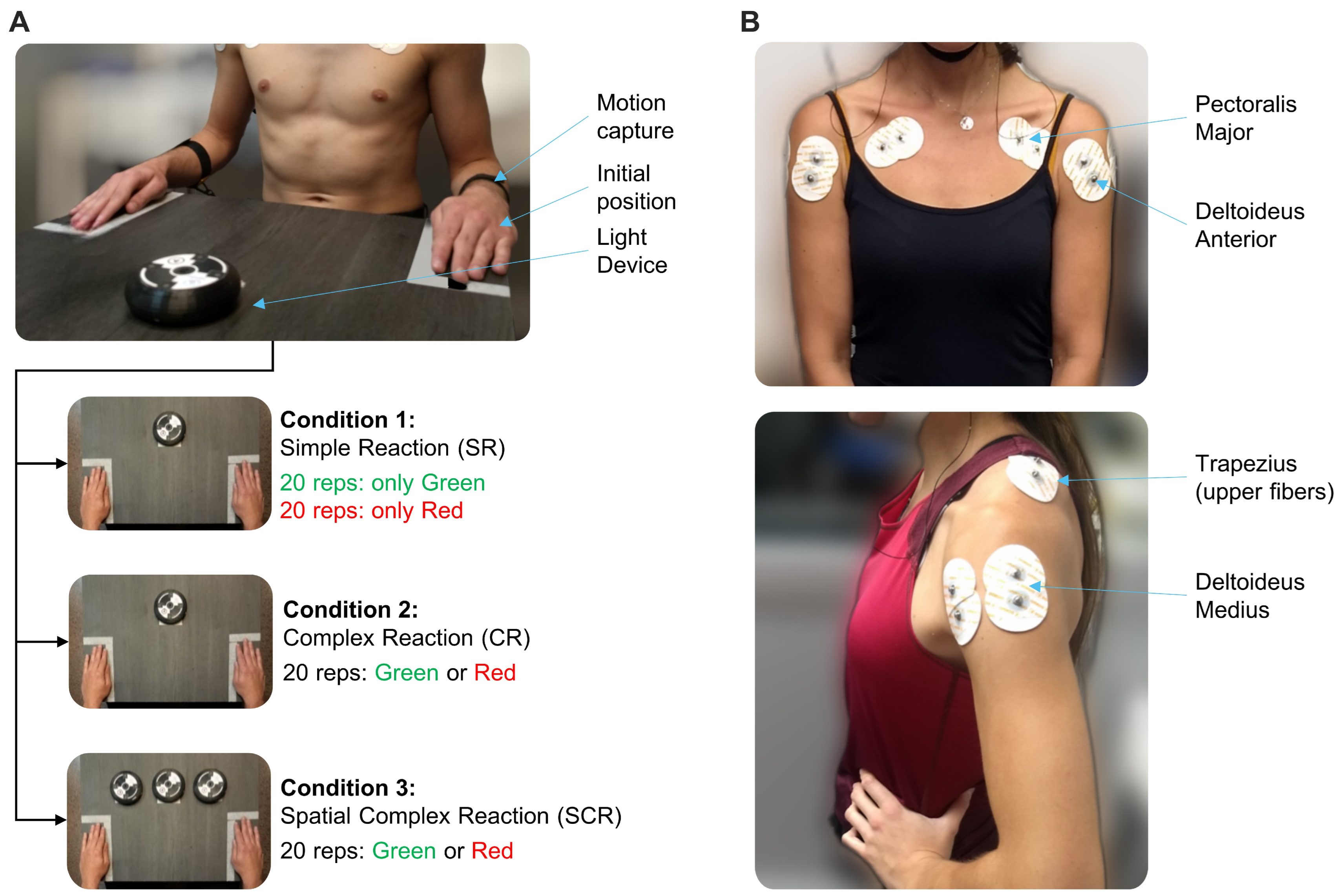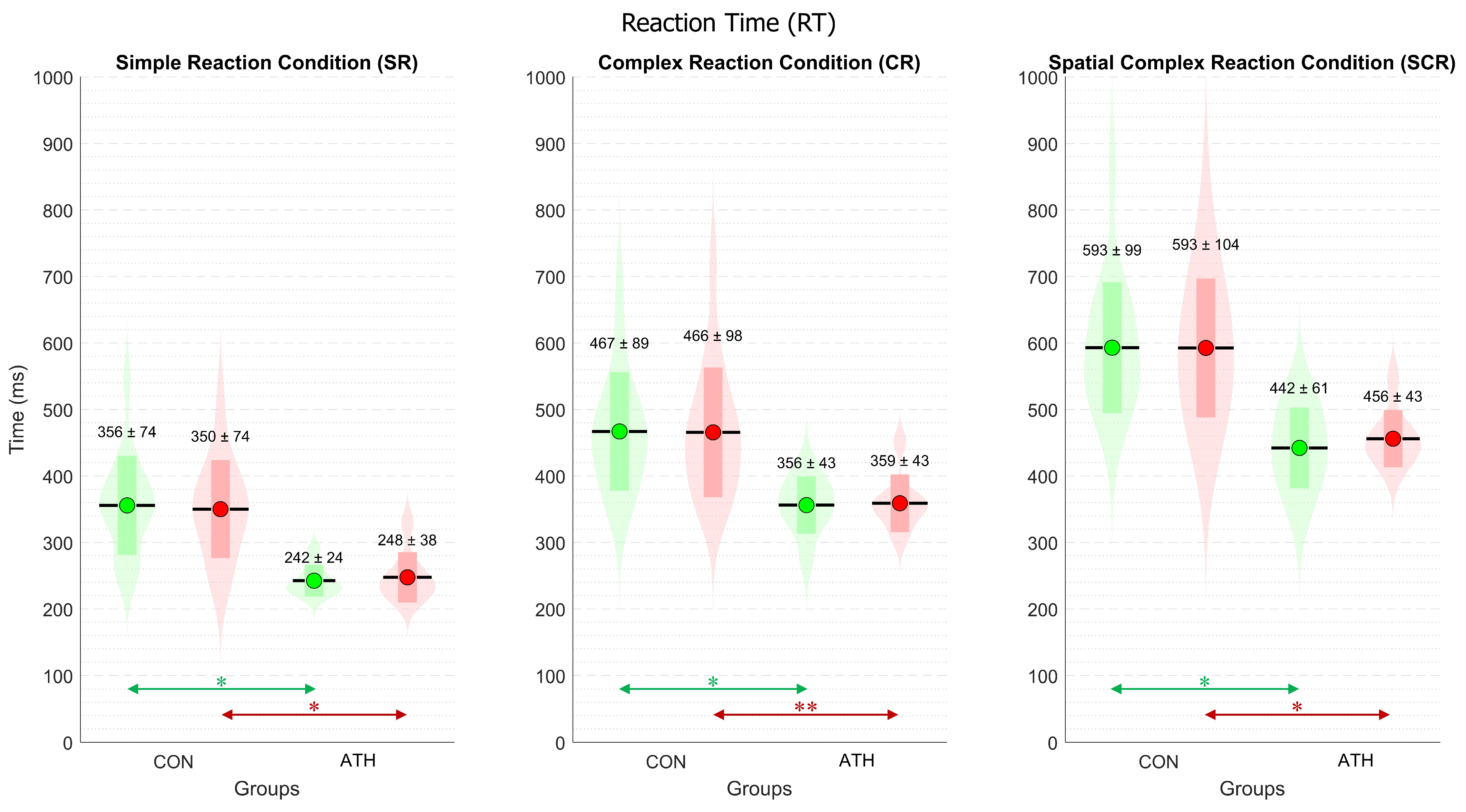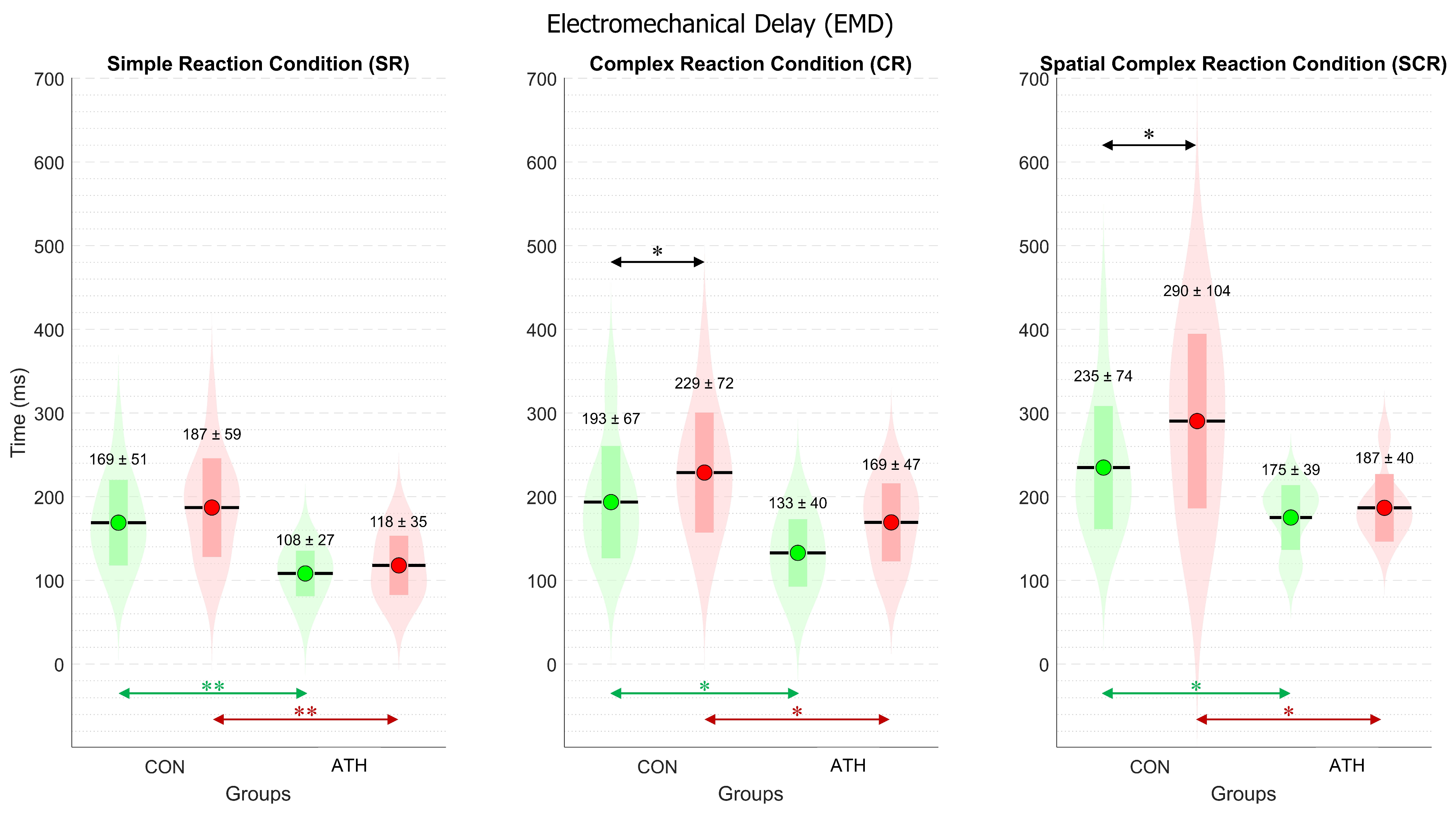Decision-Making Time Analysis for Assessing Processing Speed in Athletes during Motor Reaction Tasks
Abstract
:1. Introduction
2. Materials and Methods
2.1. Participants
2.2. Experimental Design
2.3. Instruments
2.4. Agonist Muscle Identification
2.5. Signal Processing and Phase Detection
2.6. Time Analysis
2.7. Statistical Analysis
3. Results
3.1. Analysis of Reaction Time (RT)
3.2. Analysis of Decision-Making Time (DMKTIME)
3.3. Analysis of Electromechanical Delay (EMDTIME)
4. Discussion
5. Conclusions
Supplementary Materials
Author Contributions
Funding
Institutional Review Board Statement
Informed Consent Statement
Data Availability Statement
Acknowledgments
Conflicts of Interest
References
- Woods, D.L.; Wyma, J.M.; Yund, E.W.; Herron, T.J.; Reed, B. Factors Influencing the Latency of Simple Reaction Time. Front. Hum. Neurosci. 2015, 9, 131. [Google Scholar] [CrossRef] [PubMed]
- Wong, A.L.; Goldsmith, J.; Forrence, A.D.; Haith, A.M.; Krakauer, J.W. Reaction Times Can Reflect Habits Rather than Computations. eLife 2017, 6, e28075. [Google Scholar] [CrossRef] [PubMed]
- Wong, A.L.; Haith, A.M.; Krakauer, J.W. Motor Planning. Neuroscientist 2015, 21, 385–398. [Google Scholar] [CrossRef] [PubMed]
- Cavanagh, P.R.; Komi, P.V. Electromechanical Delay in Human Skeletal Muscle under Concentric and Eccentric Contractions. Eur. J. Appl. Physiol. 1979, 42, 159–163. [Google Scholar] [CrossRef] [PubMed]
- Cè, E.; Rampichini, S.; Agnello, L.; Limonta, E.; Veicsteinas, A.; Esposito, F. Effects of Temperature and Fatigue on the Electromechanical Delay Components. Muscle Nerve 2013, 47, 566–576. [Google Scholar] [CrossRef] [PubMed]
- Correia, J.P.; Vaz, J.R.; Domingos, C.; Freitas, S.R. From Thinking Fast to Moving Fast: Motor Control of Fast Limb Movements in Healthy Individuals. Rev. Neurosci. 2022, 33, 919–950. [Google Scholar] [CrossRef] [PubMed]
- Dexheimer, B.; Przybyla, A.; Murphy, T.E.; Akpinar, S.; Sainburg, R. Reaction Time Asymmetries Provide Insight into Mechanisms Underlying Dominant and Non-Dominant Hand Selection. Exp. Brain Res. 2022, 240, 2791–2802. [Google Scholar] [CrossRef]
- Rabbitt, P. Hand Dominance, Attention, and the Choice between Responses. Q. J. Exp. Psychol. 1978, 30, 407–416. [Google Scholar] [CrossRef] [PubMed]
- Velay, J. Hemispheric Asymmetry and Interhemispheric Transferin Reaching Programming. Neuropsychologia 1999, 37, 895–903. [Google Scholar] [CrossRef]
- Barthélémy, S.; Boulinguez, P. Manual Asymmetries in the Directional Coding of Reaching: Further Evidence for Hemispatial Effects and Right Hemisphere Dominance for Movement Planning. Exp. Brain Res. 2002, 147, 305–312. [Google Scholar] [CrossRef]
- Badau, D.; Baydil, B.; Badau, A. Differences among Three Measures of Reaction Time Based on Hand Laterality in Individual Sports. Sports 2018, 6, 45. [Google Scholar] [CrossRef] [PubMed]
- Nuri, L.; Shadmehr, A.; Ghotbi, N.; Attarbashi Moghadam, B. Reaction Time and Anticipatory Skill of Athletes in Open and Closed Skill-Dominated Sport. Eur. J. Sport Sci. 2013, 13, 431–436. [Google Scholar] [CrossRef]
- Reigal, R.E.; Barrero, S.; Martín, I.; Morales-Sánchez, V.; Juárez-Ruiz De Mier, R.; Hernández-Mendo, A. Relationships Between Reaction Time, Selective Attention, Physical Activity, and Physical Fitness in Children. Front. Psychol. 2019, 10, 2278. [Google Scholar] [CrossRef]
- Theofilou, G.; Ladakis, I.; Mavroidi, C.; Kilintzis, V.; Mirachtsis, T.; Chouvarda, I.; Kouidi, E. The Effects of a Visual Stimuli Training Program on Reaction Time, Cognitive Function, and Fitness in Young Soccer Players. Sensors 2022, 22, 6680. [Google Scholar] [CrossRef] [PubMed]
- Chiu, C.N.; Chen, C.-Y.; Muggleton, N.G. Sport, Time Pressure, and Cognitive Performance. In Progress in Brain Research; Elsevier: Amsterdam, The Netherlands, 2017; Volume 234, pp. 85–99. ISBN 978-0-12-811825-2. [Google Scholar]
- Lambourne, K.; Tomporowski, P. The Effect of Exercise-Induced Arousal on Cognitive Task Performance: A Meta-Regression Analysis. Brain Res. 2010, 1341, 12–24. [Google Scholar] [CrossRef]
- Badau, D.; Badau, A.; Joksimović, M.; Manescu, C.O.; Manescu, D.C.; Dinciu, C.C.; Margarit, I.R.; Tudor, V.; Mujea, A.M.; Neofit, A.; et al. Identifying the Level of Symmetrization of Reaction Time according to Manual Lateralization between Team Sports Athletes, Individual Sports Athletes, and Non-Athletes. Symmetry 2023, 16, 28. [Google Scholar] [CrossRef]
- Wang, J.; Zhao, X.; Bi, Y.; Jiang, S.; Sun, Y.; Lang, J.; Han, C. Executive Function Elevated by Long Term High-Intensity Physical Activity and the Regulation Role of Beta-Band Activity in Human Frontal Region. Cogn. Neurodyn 2023, 17, 1463–1472. [Google Scholar] [CrossRef] [PubMed]
- Atan, T.; Akyol, P. Reaction Times of Different Branch Athletes and Correlation between Reaction Time Parameters. Procedia Soc. Behav. Sci. 2014, 116, 2886–2889. [Google Scholar] [CrossRef]
- Brisswalter, J.; Arcelin, R.; Audiffren, M.; Delignières, D. Influence of Physical Exercise on Simple Reaction Time: Effect of Physical Fitness. Percept. Mot. Skills 1997, 85, 1019–1027. [Google Scholar] [CrossRef]
- Vaeyens, R.; Lenoir, M.; Williams, A.M.; Philippaerts, R.M. Mechanisms Underpinning Successful Decision Making in Skilled Youth Soccer Players: An Analysis of Visual Search Behaviors. J. Mot. Behav. 2007, 39, 395–408. [Google Scholar] [CrossRef]
- Nakamoto, H.; Mori, S. Sport-Specific Decision-Making in a Go/Nogo Reaction Task: Difference among Nonathletes and Baseball and Basketball Players. Percept. Mot. Skills 2008, 106, 163–170. [Google Scholar] [CrossRef] [PubMed]
- Kida, N.; Oda, S.; Matsumura, M. Intensive Baseball Practice Improves the Go/Nogo Reaction Time, but not the Simple Reaction Time. Cogn. Brain Res. 2005, 22, 257–264. [Google Scholar] [CrossRef] [PubMed]
- Liguori, G.; Feito, Y.; Fountaine, C.; Roy, B. ACSM’s Guidelines for Exercise Testing and Prescription, 11th ed.; Wolters Kluwer: Philadelphia, PA, USA, 2021. [Google Scholar]
- Cano, L.A.; Albarracín, A.L.; Pizá, A.G.; García-Cena, C.E.; Fernández-Jover, E.; Farfán, F.D. Assessing Cognitive Workload in Motor Decision-Making through Functional Connectivity Analysis: Towards Early Detection and Monitoring of Neurodegenerative Diseases. Sensors 2024, 24, 1089. [Google Scholar] [CrossRef]
- Król, H.; Sobota, G.; Nawrat, A. Effect of Electrode Position on EMG Recording in Pectoralis Major. J. Hum. Kinet. 2007, 17, 105–112. [Google Scholar]
- Lee, H.-M. Force Direction and Arm Position Affect Contribution of Clavicular and Sternal Parts of Pectoralis Major Muscle during Muscle Strength Testing. J. Hand Ther. 2019, 32, 71–79. [Google Scholar] [CrossRef]
- Cheron, G.; Cebolla, A.M.; Bengoetxea, A.; Leurs, F.; Dan, B. Recognition of the Physiological Actions of the Triphasic EMG Pattern by a Dynamic Recurrent Neural Network. Neurosci. Lett. 2007, 414, 192–196. [Google Scholar] [CrossRef]
- Forgaard, C.J.; Maslovat, D.; Carlsen, A.N.; Chua, R.; Franks, I.M. Startle Reveals Independent Preparation and Initiation of Triphasic EMG Burst Components in Targeted Ballistic Movements. J. Neurophysiol. 2013, 110, 2129–2139. [Google Scholar] [CrossRef] [PubMed]
- Teruya, P.Y.; Farfán, F.D.; Pizá, Á.G.; Soletta, J.H.; Lucianna, F.A.; Albarracín, A.L. Quantifying Muscle Alterations in a Parkinson’s Disease Animal Model Using Electromyographic Biomarkers. Med. Biol. Eng. Comput. 2021, 59, 1735–1749. [Google Scholar] [CrossRef]
- Cohen, J. Statistical Power Analysis for the Behavioral Sciences; Routledge: London, UK, 2013; ISBN 978-1-134-74270-7. [Google Scholar]
- Rosenbaum, D.A. Human Movement Initiation: Specification of Arm, Direction, and Extent. J. Exp. Psychol. Gen. 1980, 109, 444–474. [Google Scholar] [CrossRef]
- Eversheim, U.; Bock, O. The Role of Precues in the Preparation of Motor Responses in Humans. J. Mot. Behav. 2002, 34, 271–276. [Google Scholar] [CrossRef]
- Keele, S.W. Behavioral Analysis of Movement. In Comprehensive Physiology; Terjung, R., Ed.; Wiley: Hoboken, NJ, USA, 1981; pp. 1391–1414. ISBN 978-0-470-65071-4. [Google Scholar]
- Carey, D.P.; Hargreaves, E.L.; Goodale, M.A. Reaching to Ipsilateral or Contralateral Targets: Within-Hemisphere Visuomotor Processing Cannot Explain Hemispatial Differences in Motor Control. Exp. Brain Res. 1996, 112, 496–504. [Google Scholar] [CrossRef]
- Hodges, N.J.; Lyons, J.; Cockell, D.; Reed, A.; Elliott, D. Hand, Space and Attentional Asymmetries in Goal-Directed Manual Aiming. Cortex 1997, 33, 251–269. [Google Scholar] [CrossRef] [PubMed]
- Klein, P.-A.; Duque, J.; Labruna, L.; Ivry, R.B. Comparison of the Two Cerebral Hemispheres in Inhibitory Processes Operative during Movement Preparation. NeuroImage 2016, 125, 220–232. [Google Scholar] [CrossRef] [PubMed]
- Poole, B.J.; Mather, M.; Livesey, E.J.; Harris, I.M.; Harris, J.A. Motor-Evoked Potentials Reveal Functional Differences between Dominant and Non-Dominant Motor Cortices during Response Preparation. Cortex 2018, 103, 1–12. [Google Scholar] [CrossRef]
- Verstraelen, S.; Cuypers, K.; Maes, C.; Hehl, M.; Van Malderen, S.; Levin, O.; Mikkelsen, M.; Meesen, R.L.J.; Swinnen, S.P. Neurophysiological Modulations in the (Pre)Motor-Motor Network Underlying Age-Related Increases in Reaction Time and the Role of GABA Levels—A Bimodal TMS-MRS Study. NeuroImage 2021, 243, 118500. [Google Scholar] [CrossRef]
- Del Vecchio, A.; Negro, F.; Falla, D.; Bazzucchi, I.; Farina, D.; Felici, F. Higher Muscle Fiber Conduction Velocity and Early Rate of Torque Development in Chronically Strength-Trained Individuals. J. Appl. Physiol. 2018, 125, 1218–1226. [Google Scholar] [CrossRef] [PubMed]
- Dos Santos, P.C.R.; Lamoth, C.J.C.; Barbieri, F.A.; Zijdewind, I.; Gobbi, L.T.B.; Hortobágyi, T. Age-Specific Modulation of Intermuscular Beta Coherence during Gait before and after Experimentally Induced Fatigue. Sci. Rep. 2020, 10, 15854. [Google Scholar] [CrossRef] [PubMed]
- Felici, F.; Del Vecchio, A. Surface Electromyography: What Limits Its Use in Exercise and Sport Physiology? Front. Neurol. 2020, 11, 578504. [Google Scholar] [CrossRef] [PubMed]
- Ofori, E.; Coombes, S.A.; Vaillancourt, D.E. 3D Cortical Electrophysiology of Ballistic Upper Limb Movement in Humans. NeuroImage 2015, 115, 30–41. [Google Scholar] [CrossRef]
- Dupont-Hadwen, J.; Bestmann, S.; Stagg, C.J. Motor Training Modulates Intracortical Inhibitory Dynamics in Motor Cortex during Movement Preparation. Brain Stimul. 2019, 12, 300–308. [Google Scholar] [CrossRef]
- Johnson-Frey, S.H.; Newman-Norlund, R.; Grafton, S.T. A Distributed Left Hemisphere Network Active during Planning of Everyday Tool Use Skills. Cereb. Cortex 2005, 15, 681–695. [Google Scholar] [CrossRef] [PubMed]
- Verstynen, T.; Ivry, R.B. Network Dynamics Mediating Ipsilateral Motor Cortex Activity during Unimanual Actions. J. Cogn. Neurosci. 2011, 23, 2468–2480. [Google Scholar] [CrossRef] [PubMed]
- d’Avella, A.; Portone, A.; Lacquaniti, F. Superposition and Modulation of Muscle Synergies for Reaching in Response to a Change in Target Location. J. Neurophysiol. 2011, 106, 2796–2812. [Google Scholar] [CrossRef] [PubMed]
- d’Avella, A.; Fernandez, L.; Portone, A.; Lacquaniti, F. Modulation of Phasic and Tonic Muscle Synergies with Reaching Direction and Speed. J. Neurophysiol. 2008, 100, 1433–1454. [Google Scholar] [CrossRef] [PubMed]
- Boonstra, T.W. The Potential of Corticomuscular and Intermuscular Coherence for Research on Human Motor Control. Front. Hum. Neurosci. 2013, 7, 855. [Google Scholar] [CrossRef] [PubMed]
- Ortega-Auriol, P.; Byblow, W.D.; Besier, T.; McMorland, A.J.C. Muscle Synergies Are Associated with Intermuscular Coherence and Cortico-Synergy Coherence in an Isometric Upper Limb Task. Exp. Brain Res. 2023, 241, 2627–2643. [Google Scholar] [CrossRef]
- Enoka, R.M.; Duchateau, J. Rate Coding and the Control of Muscle Force. Cold Spring Harb. Perspect. Med. 2017, 7, a029702. [Google Scholar] [CrossRef] [PubMed]
- Enoka, R.M.; Pearson, K.G. The Motor Untit and Muscle Action. In Principles of Neural Science; McGraw-Hill: New York, NY, USA, 2013; ISBN 978-0-07-139011-8. [Google Scholar]
- Taimela, S.; Kujala, U.M. Reaction Times with Reference to Musculoskeletal Complaints in Adolescence. Percept. Mot. Skills 1992, 75, 1075–1082. [Google Scholar] [CrossRef] [PubMed]
- Reiche, E.; Collins, K.; Genoese, F.; Walaszek, M.; Triplett, A.; Kuenze, C.; Harkey, M.; Baez, S. Lower Extremity Reaction Time in Individuals with Contact versus Noncontact Anterior Cruciate Ligament Injuries after Reconstruction. J. Athl. Train. 2024, 59, 66–72. [Google Scholar] [CrossRef]
- Armitano-Lago, C.N.; Morrison, S.; Hoch, J.M.; Bennett, H.J.; Russell, D.M. Anterior Cruciate Ligament Reconstructed Individuals Demonstrate Slower Reactions during a Dynamic Postural Task. Scand. Med. Sci. Sports 2020, 30, 1518–1528. [Google Scholar] [CrossRef]





| Right (Dominant) | Left (Non-Dominant) | |||||
|---|---|---|---|---|---|---|
| Conditions | RT | DMKTIME | EMDTIME | RT | DMKTIME | EMDTIME |
| SR | 356 ± 74 | 187 ± 37 | 169 ± 51 | 350 ± 74 | 163 ± 31 | 187 ± 59 |
| CR | 467 ± 89 | 273 ± 43 | 193 ± 67 | 466 ± 98 | 237 ± 45 | 229 ± 72 |
| SCR | 593 ± 99 | 358 ± 66 | 235 ± 74 | 593 ± 104 | 302 ± 78 | 290 ± 104 |
| Right (Dominant) | Left (Non-Dominant) | |||||
|---|---|---|---|---|---|---|
| Conditions | RT | DMKTIME | EMDTIME | RT | DMKTIME | EMDTIME |
| SR | 242 ± 24 | 134 ± 28 | 108 ± 27 | 248 ± 38 | 130 ± 35 | 118 ± 35 |
| CR | 356 ± 43 | 223 ± 38 | 133 ± 40 | 359 ± 43 | 190 ± 41 | 169 ± 47 |
| SCR | 442 ± 61 | 267 ± 44 | 175 ± 39 | 456 ± 43 | 269 ± 19 | 187 ± 40 |
Disclaimer/Publisher’s Note: The statements, opinions and data contained in all publications are solely those of the individual author(s) and contributor(s) and not of MDPI and/or the editor(s). MDPI and/or the editor(s) disclaim responsibility for any injury to people or property resulting from any ideas, methods, instructions or products referred to in the content. |
© 2024 by the authors. Licensee MDPI, Basel, Switzerland. This article is an open access article distributed under the terms and conditions of the Creative Commons Attribution (CC BY) license (https://creativecommons.org/licenses/by/4.0/).
Share and Cite
Cano, L.A.; Gerez, G.D.; García, M.S.; Albarracín, A.L.; Farfán, F.D.; Fernández-Jover, E. Decision-Making Time Analysis for Assessing Processing Speed in Athletes during Motor Reaction Tasks. Sports 2024, 12, 151. https://doi.org/10.3390/sports12060151
Cano LA, Gerez GD, García MS, Albarracín AL, Farfán FD, Fernández-Jover E. Decision-Making Time Analysis for Assessing Processing Speed in Athletes during Motor Reaction Tasks. Sports. 2024; 12(6):151. https://doi.org/10.3390/sports12060151
Chicago/Turabian StyleCano, Leonardo Ariel, Gonzalo Daniel Gerez, María Soledad García, Ana Lía Albarracín, Fernando Daniel Farfán, and Eduardo Fernández-Jover. 2024. "Decision-Making Time Analysis for Assessing Processing Speed in Athletes during Motor Reaction Tasks" Sports 12, no. 6: 151. https://doi.org/10.3390/sports12060151








